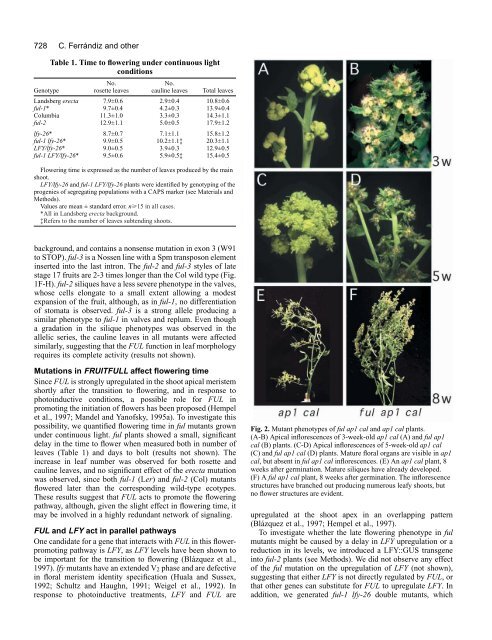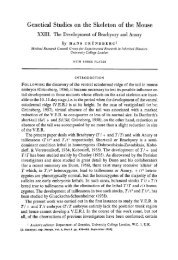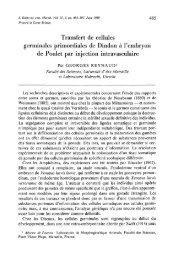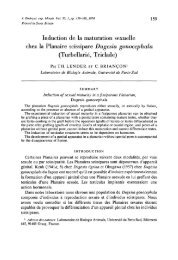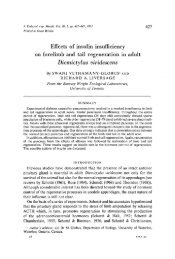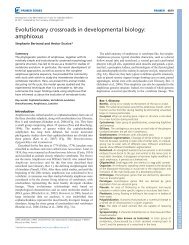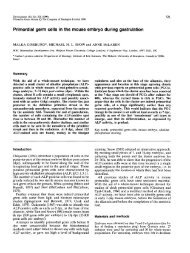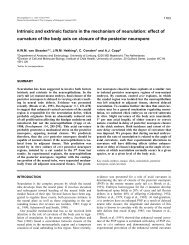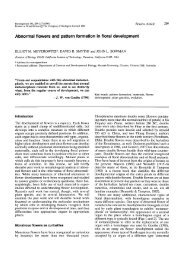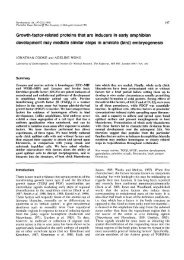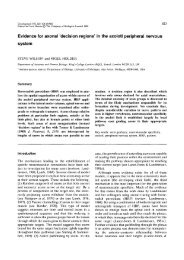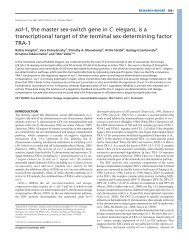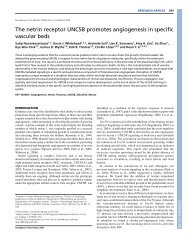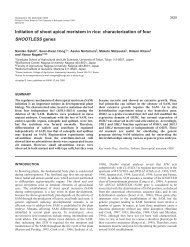FRUITFULL promotes flower development - Development - The ...
FRUITFULL promotes flower development - Development - The ...
FRUITFULL promotes flower development - Development - The ...
Create successful ePaper yourself
Turn your PDF publications into a flip-book with our unique Google optimized e-Paper software.
728<br />
C. Ferrándiz and other<br />
Table 1. Time to <strong>flower</strong>ing under continuous light<br />
conditions<br />
No. No.<br />
Genotype rosette leaves cauline leaves Total leaves<br />
Landsberg erecta 7.9±0.6 2.9±0.4 10.8±0.6<br />
ful-1* 9.7±0.4 4.2±0.3 13.9±0.4<br />
Columbia 11.3±1.0 3.3±0.3 14.3±1.1<br />
ful-2 12.9±1.1 5.0±0.5 17.9±1.2<br />
lfy-26* 8.7±0.7 7.1±1.1 15.8±1.2<br />
ful-1 lfy-26* 9.9±0.5 10.2±1.1‡ 20.3±1.1<br />
LFY/lfy-26* 9.0±0.5 3.9±0.3 12.9±0.5<br />
ful-1 LFY/lfy-26* 9.5±0.6 5.9±0.5‡ 15.4±0.5<br />
Flowering time is expressed as the number of leaves produced by the main<br />
shoot.<br />
LFY/lfy-26 and ful-1 LFY/lfy-26 plants were identified by genotyping of the<br />
progenies of segregating populations with a CAPS marker (see Materials and<br />
Methods).<br />
Values are mean ± standard error. n�15 in all cases.<br />
*All in Landsberg erecta background.<br />
‡Refers to the number of leaves subtending shoots.<br />
background, and contains a nonsense mutation in exon 3 (W91<br />
to STOP). ful-3 is a Nossen line with a Spm transposon element<br />
inserted into the last intron. <strong>The</strong> ful-2 and ful-3 styles of late<br />
stage 17 fruits are 2-3 times longer than the Col wild type (Fig.<br />
1F-H). ful-2 siliques have a less severe phenotype in the valves,<br />
whose cells elongate to a small extent allowing a modest<br />
expansion of the fruit, although, as in ful-1, no differentiation<br />
of stomata is observed. ful-3 is a strong allele producing a<br />
similar phenotype to ful-1 in valves and replum. Even though<br />
a gradation in the silique phenotypes was observed in the<br />
allelic series, the cauline leaves in all mutants were affected<br />
similarly, suggesting that the FUL function in leaf morphology<br />
requires its complete activity (results not shown).<br />
Mutations in <strong>FRUITFULL</strong> affect <strong>flower</strong>ing time<br />
Since FUL is strongly upregulated in the shoot apical meristem<br />
shortly after the transition to <strong>flower</strong>ing, and in response to<br />
photoinductive conditions, a possible role for FUL in<br />
promoting the initiation of <strong>flower</strong>s has been proposed (Hempel<br />
et al., 1997; Mandel and Yanofsky, 1995a). To investigate this<br />
possibility, we quantified <strong>flower</strong>ing time in ful mutants grown<br />
under continuous light. ful plants showed a small, significant<br />
delay in the time to <strong>flower</strong> when measured both in number of<br />
leaves (Table 1) and days to bolt (results not shown). <strong>The</strong><br />
increase in leaf number was observed for both rosette and<br />
cauline leaves, and no significant effect of the erecta mutation<br />
was observed, since both ful-1 (Ler) and ful-2 (Col) mutants<br />
<strong>flower</strong>ed later than the corresponding wild-type ecotypes.<br />
<strong>The</strong>se results suggest that FUL acts to promote the <strong>flower</strong>ing<br />
pathway, although, given the slight effect in <strong>flower</strong>ing time, it<br />
may be involved in a highly redundant network of signaling.<br />
FUL and LFY act in parallel pathways<br />
One candidate for a gene that interacts with FUL in this <strong>flower</strong>promoting<br />
pathway is LFY, as LFY levels have been shown to<br />
be important for the transition to <strong>flower</strong>ing (Blázquez et al.,<br />
1997). lfy mutants have an extended V2 phase and are defective<br />
in floral meristem identity specification (Huala and Sussex,<br />
1992; Schultz and Haughn, 1991; Weigel et al., 1992). In<br />
response to photoinductive treatments, LFY and FUL are<br />
Fig. 2. Mutant phenotypes of ful ap1 cal and ap1 cal plants.<br />
(A-B) Apical inflorescences of 3-week-old ap1 cal (A) and ful ap1<br />
cal (B) plants. (C-D) Apical inflorescences of 5-week-old ap1 cal<br />
(C) and ful ap1 cal (D) plants. Mature floral organs are visible in ap1<br />
cal, but absent in ful ap1 cal inflorescences. (E) An ap1 cal plant, 8<br />
weeks after germination. Mature siliques have already developed.<br />
(F) A ful ap1 cal plant, 8 weeks after germination. <strong>The</strong> inflorescence<br />
structures have branched out producing numerous leafy shoots, but<br />
no <strong>flower</strong> structures are evident.<br />
upregulated at the shoot apex in an overlapping pattern<br />
(Blázquez et al., 1997; Hempel et al., 1997).<br />
To investigate whether the late <strong>flower</strong>ing phenotype in ful<br />
mutants might be caused by a delay in LFY upregulation or a<br />
reduction in its levels, we introduced a LFY::GUS transgene<br />
into ful-2 plants (see Methods). We did not observe any effect<br />
of the ful mutation on the upregulation of LFY (not shown),<br />
suggesting that either LFY is not directly regulated by FUL, or<br />
that other genes can substitute for FUL to upregulate LFY. In<br />
addition, we generated ful-1 lfy-26 double mutants, which


